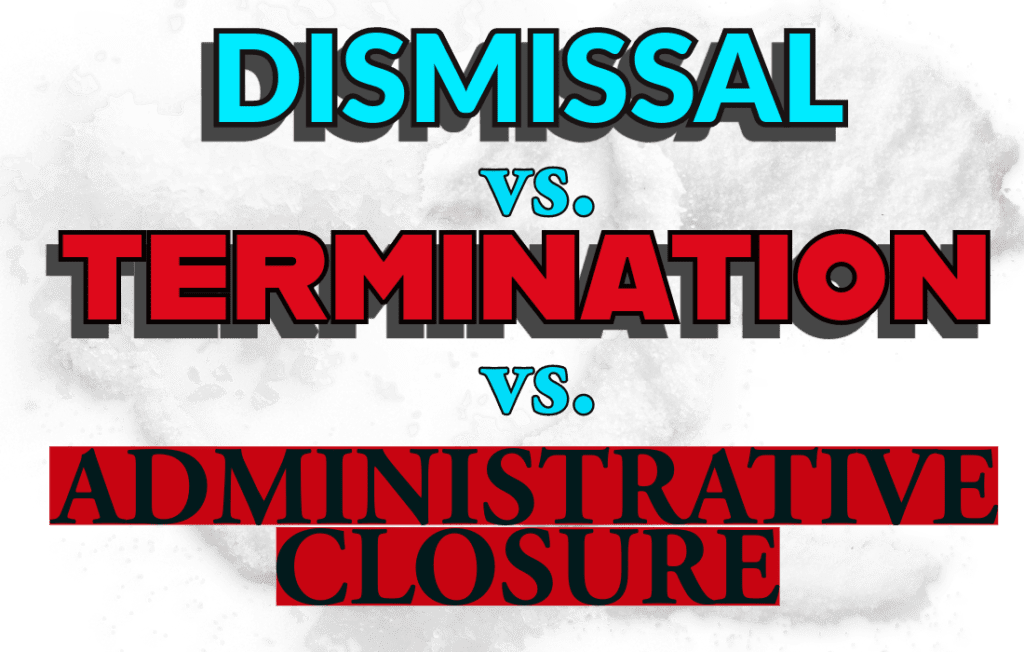Immigration removal proceedings in the Executive Office of Immigration Review, Immigration Court, can end in many different ways. Typically, if a case proceeds to its conclusion, then the Immigration Judge will either grant relief of some kind (i.e. asylum, cancellation of removal, voluntary departure) or the Immigration Judge will order the respondent removed. There are many times that cases don’t progress that far for various reasons. Perhaps the respondent is eligible to obtain an immigration benefit from the U.S. Citizenship and Immigration Service, or facts and circumstances have changed since the initiation of the proceedings and the charges can no longer be sustained.

There are also times where the Department of Homeland Security, Immigration and Customs Enforcement will offer to exercise its prosecutorial discretion to decline to pursue the case. This will happen most often in cases where the respondent is extremely sympathetic but may not qualify for any relief from removal under the law.
In any of those circumstances, the proceedings would need to be disposed of in some way. Often times people ask about the different ways that may be achieved be it dismissal, termination, or administrative closure. These terms should not be used interchangeably. They are three distinct legal procedures with different legal consequences.
Termination
Proceedings may only be terminated when there is a legal basis for doing so. A motion to terminate asks an Immigration Judge to end the proceedings by alleging that the government’s charges are substantively or procedurally defective. The Immigration Judge’s authority to terminate proceedings are limited by regulations 8 CFR § 1003.10(b) and 8 CFR § 1003.1(d)(1)(ii), which give Courts and the BIA the power to take “any action” that is “appropriate and necessary” to dispose of a case.
The Board defined the specifics of this in more detail in in Matter of S-O-G- & F-D-B-. The AG later set the rule that controls now from Matter of S-O-G-. In Matter of S-O-G, the AG held that Immigration Judges, “have no inherent authority to terminate or dismiss removal proceedings” even if a case presents compelling circumstances, restricting Immigration Judge’s discretion to terminate. However, the decision also held that the IJ can terminate proceedings if it is expressly authorized by (1) 8 C.F.R. § 1239.2(f), where a respondent is eligible for naturalization, has a pending naturalization application, and has exceptionally appealing or humanitarian factors in their case, and (2) under 8 C.F.R. § 1239.2(c) where DHS moves to dismiss a notice to appear.
This decision, however, does not affect motions to terminate that are grounded in law. An Immigration Judge continues to maintain the authority to terminate for any nondiscretionary basis supported by the BIA or judicial decisions, for example lack of subject matter discretion, improperly served NTA, regulatory violations, or res judicata.
Termination is like dismissal in that is completely ends the removal proceedings. Any applications before the Court are no longer pending and nothing further must be done to pursue another immigration benefit through other means.
Termination can be with or without prejudice. If with prejudice then the respondent cannot be put into removal proceedings again for the same reasons in that first Notice to Appear.
Dismissal
This regulations at 8 CFR § 1239.2(c) allow for the government to seek dismissal of the case based on grounds set out in 8 CFR § 239.2(a). These grounds are where the respondent: (1) is a national of the U.S.; (2) is not deportable or inadmissible; (3) is deceased; (4) is not in the U.S.; (5) failed to file a timely petition but the failure was excused; (6) the NTA was improvidently issued; or (7) circumstances in the case have changed.
Dismissal is most commonly used in the context of the exercise of prosecutorial discretion (“PD”). When the Department moves for dismissal for PD that is typically going to be based on the seventh ground, circumstances in the case have changed. Many times a Motion to Dismiss will be brough as a Joint Motion To Dismiss or it may be brought orally as such, as it has become a common practice. However, the regulation states that only DHS can bring the motion, so it is technically the Department’s motion, and if certainly not a motion that a respondent can file on their own.
Motions to dismiss are always without prejudice to the Department. That means that the government can always bring a new case against that person even for the same reasons they did the firs time. Once the case is dismissed it is done. The respondent returns to the same position that they were in prior to being put into removal proceedings. If they had no immigration status then they return to being in the US without any immigration status. Any application for relief that they filed with the Court will either be withdrawn or abandoned and will no longer be pending with the Court. If the respondent applied for asylum then their case is dismissed, that asylum application is not pending any longer and there will not be a decision made on it in the future.
Since there are proceedings or applications pending that also means that there are no longer grounds for the respondent to obtain employment authorization document (EAD) based on a pending application. Any EAD that was issued based on a pending application for relief will be terminated on the date the case is dismissed since they no longer have that basis for obtaining it. This is the biggest difference from administrative closure, which is how the government would grant PD often times years ago (discussed more in the admin closure section).
Since dismissal disposes of the removal proceedings completely if the respondent seeks to obtain a different immigration benefit in the future there is nothing they need to do first in respect to the removal proceedings. This too is different from administrative closure.
Administrative Closure
Administrative closure can be requested by either the government or the respondent. It may be offered by the government when they prefer not to take testimony or where there potential issued regarding whether someone should receive asylum or another form of relief. This may occur if there are issues with jurisdiction, timeliness, or other procedural matters. When administratively closed, your case technically remains “pending” with the immigration court and can be re-opened at any time by either party or the judge.
The greatest benefit of administrative closure is that employment authorization remains valid and can continue to be renewed since the underlying application for relief is still pending, although there are no future hearing dates being scheduled and that application will not ever be adjudicated unless things change.
When a case is administratively closed a person remains in removal proceedings. It is essentially just removing the case from the Court’s calendar so there are no more future hearing dates, but the case is still before the Court. If the respondent wants to pursue relief before USCIS they would need to dispose of the case before the Court first since jurisdiction is still vested with the Court. For the same reason the respondent cannot leave the country without “self-deporting.”


Leave a Reply
You must be logged in to post a comment.